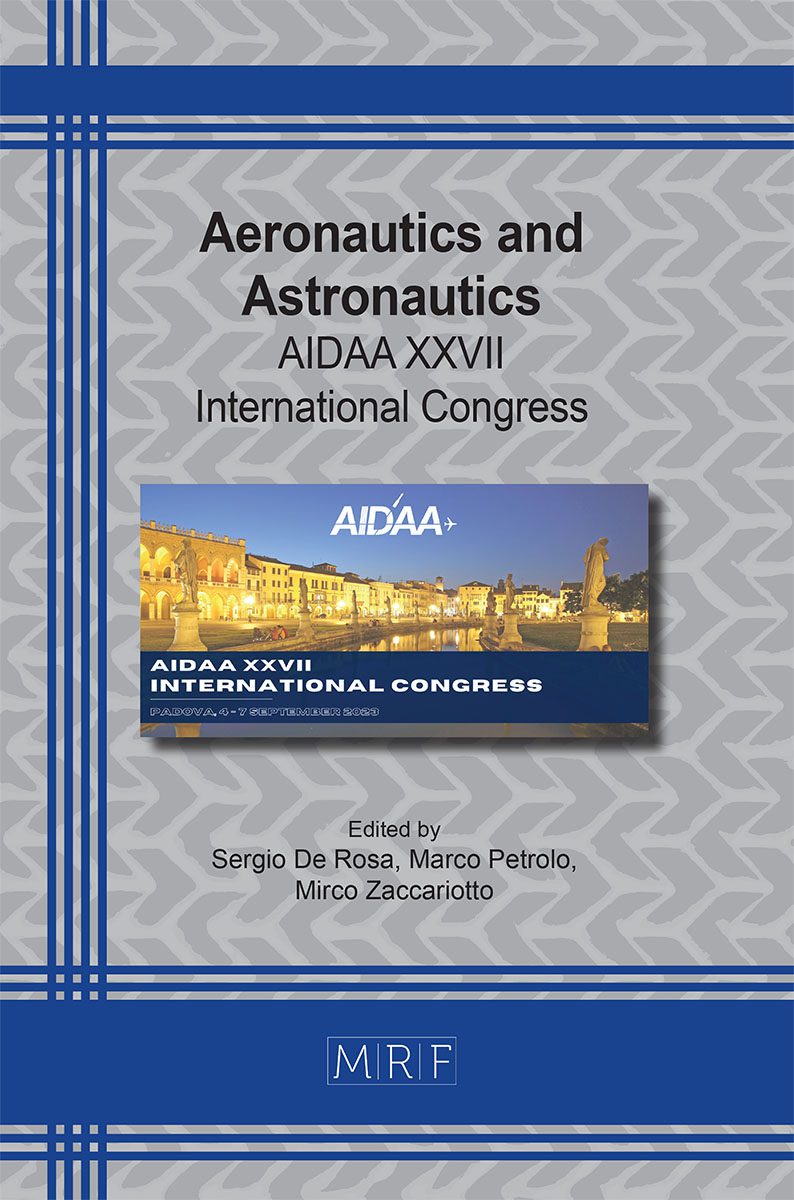New insights on limit cycle oscillations due to control surface freeplay
Nicola Fonzi, Sergio Ricci, Eli Livne
download PDFAbstract. A new experimental wind tunnel test-bed has been developed for the study of limit cycle oscillations induced by control surface freeplay. Studies of the effects of a single nonlinearity, made possible by the new horizontal tail plane, are described here. Several effects are considered, starting from a reference configuration: the effect of changes in inertia and stiffness, a time-varying gap size, and an aerodynamic preload due to an angle of attack. Both time marching simulations and describing functions analytical methods have been used to understand the experimental measurements and study the capability of the methods to capture the physical behavior. Good agreement was found in all cases and physical insights are gained from the mathematical models. Limitations of the analytical tools are also addressed, focusing on the important difference between the self-excited dynamics of the nonlinear system and its forced response to external excitations.
Keywords
Aeroelasticity, Flutter, Limit Cycle Oscillation
Published online 11/1/2023, 4 pages
Copyright © 2023 by the author(s)
Published under license by Materials Research Forum LLC., Millersville PA, USA
Citation: Nicola Fonzi, Sergio Ricci, Eli Livne, New insights on limit cycle oscillations due to control surface freeplay, Materials Research Proceedings, Vol. 37, pp 38-41, 2023
DOI: https://doi.org/10.21741/9781644902813-9
The article was published as article 9 of the book Aeronautics and Astronautics
![]() Content from this work may be used under the terms of the Creative Commons Attribution 3.0 license. Any further distribution of this work must maintain attribution to the author(s) and the title of the work, journal citation and DOI.
Content from this work may be used under the terms of the Creative Commons Attribution 3.0 license. Any further distribution of this work must maintain attribution to the author(s) and the title of the work, journal citation and DOI.
References
[1] J. Panchal and H. Benaroya, “Review of control surface freeplay,” Prog. Aerosp. Sci., vol. 127, p. 100729, Nov. 2021. https://doi.org/10.1016/j.paerosci.2021.100729
[2] D. D. Bueno, L. D. Wayhs-Lopes, and E. H. Dowell, “Control-surface structural nonlinearities in aeroelasticity: A state of the art review,” Aiaa J., vol. 60, no. 6, pp. 3364–3376, 2022. https://doi.org/10.2514/1.J060714
[3] G. Dimitriadis, Introduction to Nonlinear Aeroelasticity. Chichester, UK: John Wiley & Sons, Ltd, 2017. doi: 10.1002/9781118756478
[4] E. J. Breitbach, “Flutter Analysis of an Airplane With Multiple Structural Nonlinearities in the Control System,” NASA Technical Paper 1620, 1980.
[5] R. M. Laurenson and R. M. Trn, “Flutter Analysis of Missile Control Surfaces Containing Structural Nonlinearities,” AIAA J., vol. 18, no. 10, pp. 1245–1251, 1980. https://doi.org/10.2514/3.50876
[6] C. L. Lee, “An Iterative Procedure for Nonlinear Flutter Analysis,” AIAA J., p. 8, 1986. https://doi.org/10.2514/3.9352
[7] B. H. K. Lee and A. Tron, “Effects of structural nonlinearities on flutter characteristics of the CF-18 aircraft,” J. Aircr., vol. 26, no. 8, Art. no. 8, Aug. 1989. https://doi.org/10.2514/3.45839
[8] M. Manetti, G. Quaranta, and P. Mantegazza, “Numerical Evaluation of Limit Cycles of Aeroelastic Systems,” J. Aircr., vol. 46, no. 5, Art. no. 5, Sep. 2009. https://doi.org/10.2514/1.42928
[9] Y.-J. Seo, S.-J. Lee, J.-S. Bae, and I. Lee, “Effects of multiple structural nonlinearities on limit cycle oscillation of missile control fin,” J. Fluids Struct., vol. 27, no. 4, Art. no. 4, May 2011. https://doi.org/10.1016/j.jfluidstructs.2011.02.009
[10] M. A. Padmanabhan, “Sliding wear and freeplay growth due to control surface limit cycle oscillations,” J. Aircr., vol. 56, no. 5, Art. no. 5, 2019. https://doi.org/10.2514/1.C035438
[11] N. Fonzi, H. Curasi, S. Ricci, and E. Livne, “Experimental Studies on Dynamic Freeplay Nonlinearity,” in 19th International Forum on Aeroelasticity and Structural Dynamics (IFASD 2022), 2022, pp. 1–20.
[12] N. Fonzi, S. Ricci, and E. Livne, “Numerical and experimental investigations of freeplay-based LCO phenomena on a T-Tail model,” in AIAA Scitech 2022 Forum, San Diego,CA,U.S.A., May 2022. https://doi.org/10.2514/6.2022-1346












